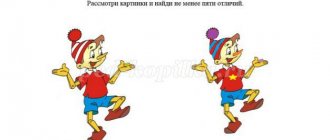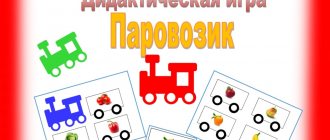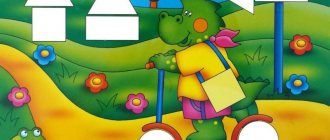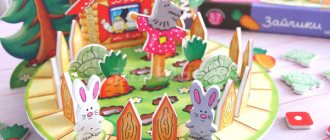Didactic games in fine arts in the younger group
Let's consider what classes in fine arts can be taught to pupils aged 2-3 years. Making each game presented with your own hands using fine art is as easy as shelling pears.
Choose a color for the item
Prepare 6 sheets of colored paper. Find images of 6 objects that match in color. Cut out the objects according to the shape so that when you apply the image to the paper, each object acquires the desired color:
- tomato – red;
- carrot – orange;
- lemon – yellow;
- apple – green;
- flower – blue;
- eggplant – purple.
Cockerel
Draw a cockerel using 5-7 colors. Prepare a palette - small squares of different colors, including those that are present in the colors of the bird. The children's task is to find squares that match the color of the cockerel.
Assemble the pattern
Create simple patterns from geometric shapes and floral elements. Cut out shapes of similar colors and shapes separately. Let the children assemble the pattern according to the sample.
Choose by color
The game is designed to reinforce the names of the main colors. Children activate self-control when perceiving colors.
Take a box containing at least 10 colored pencils. Show the students each pencil in turn, asking them to name objects of a similar color located in the room or outside the window.
Make up a picture
There are visual and didactic games that develop intelligence, the ability to concentrate, compare, and analyze.
Find pictures that clearly depict vegetables and fruits, cut them into 4-6 parts. Invite the children to reconstruct the image.
Balloons
Cut out circles and ovals - the base of the balloons. Make strips separately - these will be the strings for the balls. Lay out the blanks on the table. Ask your child to match the balls with strings of a similar color.
Match the saucer to the cup
The game not only develops the skill of distinguishing shades of the palette, but also develops concentration and motor skills of the fingers.
Prepare a canvas that imitates store shelves, make dishes of different colors from cardboard. Tell the children that the saucers were brought to the store first, then the cups. Vendors need help arranging dishes correctly. The players' task is to choose the right saucers for the cups.
Unusual picture
The game develops imagination in younger preschoolers.
Place a wide plate on the table in front of each student and sprinkle with semolina. Explain that semolina is not only tasty, it is so fine and crumbly that you can use it to create beautiful pictures by drawing with your finger.
Pick up red items
For the game, prepare various small objects (or cards representing them). Dress the doll in a red dress. Tell the students that a girl Masha came to them and asks them to help her choose items of the same color to go with her red outfit. Children take turns taking cards and saying whether the depicted object can be red. If yes, put the picture in Masha's doll's purse.
Features of unusual technology
Non-traditional drawing techniques in kindergarten and at home help develop spatial thinking, eye, and coordination. After all, the baby needs to connect the ratio of the sizes of the parts into a single composition and arrange them harmoniously on the sheet. When working on a complex decorative composition, the child learns to plan his actions and choose the appropriate material. It is very important for him to understand that he can create something with his own hands.
Everyone knows that drawing is one of our children’s favorite activities. With great pleasure they draw with colored pencils, felt-tip pens, paints, dipping a brush into a bright substance. Why not dip your finger there or smear paint all over your palm? Fine art cannot have boundaries; it is necessary to destroy all boundaries of the familiar and traditional!
Unconventional drawing techniques attract our fidgets much more, because they do not require perseverance, allow them to more clearly reveal their potential during creativity, and introduce the child to the opportunity to unusually use the things around us as materials for creativity. If the most unusual colors and bright pencils no longer arouse the child’s former interest, then you can dilute your fidget’s creativity with other drawing methods. Why is drawing in unconventional ways useful in kindergarten and at home?
- The baby uses a variety of materials, recognizes differences in textures, which allows him to improve fine motor skills.
- There is an acquaintance with volume, shape and space, which develops imagination.
- The ability to combine and mix shades develops aesthetic taste.
- The use of unusual materials develops thinking and teaches one to make non-standard decisions.
- Drawings using such techniques come out much faster, which pleases the little ones who lack perseverance.
- It adds self-confidence and faith in your abilities, because even without outstanding skills you can create a unique “masterpiece”!
All the most interesting techniques and methods were collected and systematized by G.N. Davydov in the book “Non-traditional drawing techniques in kindergarten.” This book is an excellent assistant both for the teacher and for the mother who wants to diversify her leisure time with her baby.
Didactic games in fine arts in the middle group
For older children, offer games to develop color vision and imagination, the ability to understand the mood of a picture, compose figures and patterns in compliance with symmetry and spatial relationships.
Cheerful caterpillar
Make circles in different shades. Tasks for children - to make caterpillars from circles in different variations:
- from dark to light shades;
- from cold to warm.
Colorful arithmetic
The circles used for the previous game can be used for another activity that develops color perception. Additionally, draw arithmetic signs: plus, minus, equal. Make the circles in different ways, and the students must guess what shade they will get.
For example:
- red + yellow = orange;
- green – yellow = blue;
- blue + white = light blue.
Palette
Paint the seasons using 4 separate palettes. Place landscapes (autumn, winter, spring, summer) in front of the students. Showcase the palettes you used. The task is to determine by the combination of colors what palette each landscape was painted with.
Bunny
The game develops imagination. Children learn schematic representations of living beings.
For this lesson you will need ovals of different sizes and elongations cut out of cardboard. Invite the players to create a bunny standing on its hind legs from the available figures. If desired, let the children try to place other animals.
Decorate your mitten
The game teaches how to create patterns taking into account spatial relationships and symmetry. Place a mitten cut out of paper and a set of geometric shapes in front of your child. The task is to create a beautiful and symmetrical pattern.
Playing in visual arts can instill the skill of cooperation and interaction. To do this, divide the kindergarteners into pairs and distribute mittens: one with the right one, the other with the left. Let them try to make the same patterns.
Plasticine vase
Let the child connect 2-3 small pieces of plasticine of different shades and knead them well to obtain streaks reminiscent of marble. From the resulting mass he will fashion a vase.
Magic palette
The game develops the perception of the colors of the surrounding world and an emotional response to the beauty of nature.
Give participants square colored cards. Name a natural object. Children must remember how it is colored and pick up the corresponding cards. For example, with the word “birch”, white, black, green squares should be raised. When you hear the word “chamomile” – yellow, white, green. The participant who picks up the wrong card is eliminated.
Painted horses
The game reinforces the idea of the main types of Russian folk paintings.
Prepare painted horses and images of four pastures called “Gzhel”, “Dymka”, “Gorodets”, “Filimonovo”. The child must say what painting each figurine is decorated with and place it in the corresponding pasture.
Artistic constructor
Distribute pencils and sheets of paper with outlines of simple shapes to the students. Offer to complete the images to create recognizable objects.
Drawing with foam rubber
There is another unconventional drawing technique, similar to a stamp, but with an interesting feature - drawing with foam rubber. Cut a small piece from an ordinary sponge, dip it in paint and cover the sheet with gentle pressure. This is how you easily and simply get a wonderful background for further drawing, and if you use stencils or templates for children’s drawing, you will get an amazing floral or geometric pattern.
Didactic games in fine arts in the senior group
In classes with older preschoolers, it is worth paying attention to the emotional side of fine art, developing an understanding of the genres of painting, and developing the skill of constructing a composition.
Draw a portrait
To play, draw 4-5 portraits depicting human emotions: joy, fear, surprise, sadness, anger. Cut the images into 3 parts: forehead and eyes, nose, mouth and chin. For clarity, show several famous painting portraits. Explain what genre this is. Invite participants to become artists and create portraits with different emotions from parts of the face.
Make up a landscape
Place cards on the table depicting various objects of the surrounding world. Ask to choose those from which you can make a landscape.
Collect a still life
Cut out pictures of fruits, vegetables, berries, flowers, mushrooms, vases, baskets, jugs. Ask the children to create a beautiful still life.
Happy or sad
Like the didactic game “Artist,” this activity teaches you to correlate mood with palette.
As visual material, use realistic illustrations from books and reproductions of famous paintings. Show the image to your students and ask them to determine what mood it conveys and why. Children should explain that fun is reflected in bright, rich, light colors, and sadness is reflected in dull, dark, dull colors.
Sea
The game teaches you how to build an artistic composition and develops logical thinking.
Prepare a picture of an empty sea with a background of seaweed and a sandy bottom. Separately depict underwater inhabitants: fish, snails, shells, dolphin, whale, seahorse and others. Explain to the participants that the sea inhabitants hid. To see them, you need to solve riddles. A child who correctly guesses a living creature attaches its picture to the underwater landscape.
What will happen?
Place a piece of paper and pencils in front of the players. Children take turns drawing. One draws a line and gives the sheet to the other participant. He continues the drawing with the second line and passes the baton. And so on until the drawing is ready. At the end, everyone looks at what happened.
What doesn't happen?
Offer kindergarteners a game to develop their imagination. Let them draw something that does not exist. Each participant demonstrates his creation and explains what he depicted. The others discuss whether there really is no such object in the world.
Classics in an unconventional interpretation
Let's put away the stamps and salt, wipe off our paint-stained pens, and get out the watercolors and brushes. Boring? It’s not boring at all, but very interesting, because with the help of classic watercolor paints we will create miracles!
You need to take thick paper (the best option is special watercolor paper) and wet it until it is sufficiently wet. Put a little paint on the brush and lightly touch the brush to the wet paper. The movements should be light and smooth, the beauty of the result depends on this. Before your eyes, a drop of paint spreads in different directions, turning into something amazing! It's a good time to tell your child about the rules for getting new colors and shades. Now this practice is most obvious. The resulting unimaginable divorces will serve as an interesting backdrop for future creative works.
The next unconventional drawing technique that we will consider, also from the category of “miracles nearby”, is called “Aquatype”.
This is a technique of painting with paints and water, also known as water printing. Just as in the previous method, we will need thick paper, we will choose no less traditional paints - gouache, we also need black or any dark ink. Think with your child, what would he like to portray? This method produces unusually beautiful flowers. After the paints have dried, paint over the entire sheet of paper with ink, then immerse your work in a bowl of water and enjoy the wonderful transformations! The gouache will all dissolve, leaving only your drawing on a dark background. Why isn't it magic?
The series of incredible transformations is not over! Let's take the same thick paper and use wax crayons (if you don't have them at hand, you can use an ordinary candle) apply a drawing or pattern. Next, apply watercolor paint to the entire sheet (the areas treated with wax will not be painted). A drawing will appear on a colored watercolor background, which will be a surprise for the baby, because when you draw with colorless chalk on a white sheet, it is quite difficult to imagine the end result. The process of magic can also ultimately bring quite a practical result.
Making “marble paper” is an extremely exciting activity that kids really like: it’s fun to play with things that are not allowed to be taken at all. For example, dad's shaving foam. To work you will need:
- shaving foam;
- watercolor paints;
- flat plate;
- sheet of thick paper.
First you need to get a saturated solution: mix the paint with water. Then apply a thick layer of shaving foam to the plate, and add a few bright drops of paint in a chaotic manner. Using a brush, we paint drops of paint on the foam, creating intricate zigzags and patterns. Here it is - a magical mystery that will completely absorb an enthusiastic child. And here is the promised practical effect. We apply the sheet to the rainbow foam, and then turn it over so that the foam is on top of the sheet. We remove the remaining foam on the paper with a scraper. And - lo and behold! Unimaginable stains appear from under the foam, similar to a marble pattern. The paper has absorbed the paint. After drying, “marble paper” can be used in making crafts or as an addition to decoration.
Didactic games in fine arts in the preparatory group
When preparing kindergarteners for school, it is important to teach them to describe pictures and their feelings from what they see, to show imagination in everyday life, and to be attentive and observant.
Guess the picture
For the game, prepare reproductions of paintings familiar to kindergarteners. Describe each image verbally and let the children guess what it is about. For example: “In a bright room, a girl in a pink jacket is sitting at a table, she has a fruit in her hands” - this is “Girl with Peaches” by Valentin Serov. Or: “A mother bear and three cubs are frolicking on fallen trees in the middle of a pine forest” - this is “Morning in a Pine Forest” by Ivan Shishkin.
Guess by profile
Prepare recognizable contour profiles of fairy-tale characters: Baba Yaga, Kashchei, the Little Humpbacked Horse, the Serpent Gorynych and others. Children must guess who is pictured.
What does the painting smell like?
Show your students reproductions of paintings. Let them imagine what smells they will smell when they suddenly find themselves inside the painting.
How does the picture sound?
The game is similar to the previous one, only here they imagine not by smell, but by hearing. Let the children imagine what sounds they will hear when they are inside the painting.
What do clouds look like?
If the weather and sky conditions permit, take the group for a walk. If not, find beautiful photos of cumulus clouds. Invite students to imagine what they look like. Emphasize that clouds come in different shapes and sizes.
What's missing?
Show the children some reproductions of famous paintings. Cover up any detail in the images. Show the pictures again and ask them to remember which element is hidden.
Portrait of a neighbor
The game teaches you to correctly and correctly describe a person.
Give participants cardboard frames. Let everyone, bringing the frame closer to their neighbor’s face, try to create a verbal portrait of him.





